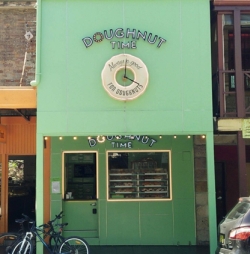Opening of the Tramsheds and History of the Tramsheds and Harold Park
As we live nearby we are very conscious of the popularity of the Tramsheds and how many locals, as well as some from further afield, now use it for their shopping and eating. Generally parking is limited and expensive, and this encourages people to access the Sheds on foot or via public transport. Be warned that the restaurants are extremely popular, so unless you are prepared to take whatever is available it is a good idea to book ahead.
It was a condition of the Agreement between the City and Mirvac that Mirvac commission a history of the Tramsheds and Harold Park. It was written by professional historian Susan Marsden, with the assistance of Max Solling and a series of interviews with residents, including members of the Society. It was released to coincide with the opening of the Tramsheds. The Society will let you know when the History becomes more generally available.

25 Glebe Point Rd, ‘Doughnut Time’
The Society objected to this proposal which, among other problems, included a neon advertising sign covering the posted balcony. It has been refused by Council as detrimental to the Conservation Area and contrary to Council’s controls. The subcommittee will continue to monitor the situation.
Central Sydney Planning Strategy
The City has put a lot of effort into a strategy to allow the CBD to grow without compromising its general character. The result is an increase in floor space for businesses so business remains the main function of the CBD. The City is concerned to retain the balance between business and residential uses.
Minor Changes to LEP 2012
The City has advertised some changes to the current LEP, now four years old. In a few instances they may have some slight impact on Glebe, but they are mainly directed at the CBD and major projects. It broadens the areas where public art may be installed, makes possible demolition where there is an existing Development Control Plan, and clarifies existing non-residential uses in residential zones. The Society will keep watch to ensure there are no adverse impacts.










There are no comments yet. Please leave yours.